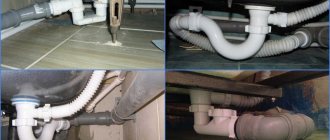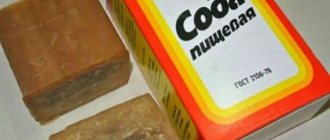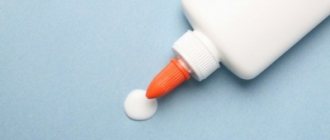A clog in a pipe can completely paralyze all household work, so you need to get rid of it as quickly as possible.
Of course, you can go to the store and buy an expensive pipe cleaner, but there is also a simpler and less expensive option - use improvised means that are found in every home.
Read the article below to learn how to clear clogs with baking soda and vinegar.
Will the remedies help cope with the problem?
Baking soda and vinegar can really clear up clogs. This effect is due to a special reaction that develops during their interaction. When soda and acid combine, 3 substances are released:
- water;
- carbon dioxide;
- sodium acetate.
Gas fills the space, displacing organics, grease and soap deposits that cause clogs, and water and sodium acetate only enhance this effect. Therefore, the combination of “soda + vinegar” can be used to combat traffic jams in pipes.
Features of blockages
The appearance of “plugs” in pipes can be caused by several reasons. The most common are carelessness of household members. More complex ones are related to the structure of the sewer network in the house. The most common causes of system blockage are:
- Waste. Throwing paper, napkins, and other debris down the toilet will sooner or later lead to clogged pipes. You should also be careful with food waste. When washing dishes, many people find it much easier to flush leftover food down the drain than to clean it out of the sink and throw it in the trash.
- Silt and fat accumulations. The process of silting of pipes and the appearance of fat on their walls is inevitable, so it is necessary to periodically carry out preventive cleaning.
- Mistakes when designing a sewerage system.
Almost all causes of blockages are the result of human carelessness. Therefore, when operating a home sewer system, it is very important to take preventative measures.
We recommend reading: How to quickly clean a microwave with vinegar
Pros and cons of use
Baking soda and vinegar, as a means to combat blockages, have their advantages and disadvantages. Obvious benefits include:
The substances are safe for pipes. They can be used to treat metal and plastic waste, regardless of how old the installation was.- Safety for human health. Baking soda and vinegar are food preservatives, so when used correctly they are not harmful to the body.
- Quick effect. If the traffic jam is small, you can deal with it in 5-15 minutes.
- Elimination of unpleasant odor.
- Universal recipe. It can be used to treat sink, bathtub, kitchen sink, shower and toilet drains.
- Affordable price. A pack of soda and a bottle of vinegar will cost 40-50 rubles. While specialized products cost at least 150 rubles.
The main disadvantage is that soda and vinegar are not able to cope with complex blockages. They help eliminate only small plugs of hair, grease and soap.
Advantages and disadvantages of using funds
The main advantage of using these drugs is tangible economic benefits. These products can be found in almost any home; their cost compared to special cleaning products is ten times lower. It is also not difficult to purchase them; just visit the nearest store.
Baking soda in combination with acid acts as an anti-corrosion agent, removing rust marks and drips. They will not damage pipes made of any material: metal, plastic, cast iron.
Unlike advertised drugs based on chemical compounds, folk remedies do not harm the health of humans and animals. In addition, they significantly reduce the time for treatment, which takes from 5 minutes for prevention and up to 8 hours for complex blockages. The prepared solution effectively fights fat, eliminates plaque and unpleasant odors. Can be used for cleaning kitchen sinks, bathroom sinks and other plumbing fixtures.
Of the shortcomings, only one is highlighted - the inability to remove complex blockages that have formed due to inorganic debris. Only radical measures using aggressive means will help here.
How to clean the toilet?
A blockage in the toilet can form due to an excess amount of toilet paper, when personal hygiene products and even stale food get into the pipe. To cope with the problem, use baking soda and vinegar.
Features of the procedure:
- half a pack of soda is introduced into the drain;
- pour 500 ml of vinegar 9% into it;
- treat the surface of the toilet with a brush, paying special attention to the drain hole;
- lower the lid of the toilet seat and leave the mixture to act for an hour;
- Once again, go over the toilet with a brush and drain the water.
If the blockage is serious, it is recommended to wash off the mixture with hot (not boiling) water. Its maximum temperature is 50 degrees.
Rules for using funds
When the first signs of a blockage occur, determine the area where the problem arose. First, remove the siphon at the junction of the pipe and the device. Clean the element from contamination, open the hot water tap, and make sure that the liquid flows freely. If the flushing steps do not help, proceed to mechanical manipulation using a metal cable and a plunger. Upon completion of the work, use a solution consisting of soda and vinegar to better clean the inlet.
Precautionary measures
If the conditions when working with vinegar essence are not met, you can get chemical burns to the skin, damage to the respiratory organs, esophagus, and kidneys. Therefore, before using the strongest chemical element, precautions are taken.
Before the cleaning procedure, prepare protective equipment: rubber gloves, goggles, mask. The respirator must contain carbon to protect against vapors. Select special clothing with long sleeves to avoid contact of the substance with the skin of the hands. It is strictly forbidden to inhale vapors or taste the essence.
If you accidentally get sodium bicarbonate or vinegar on your skin, you should immediately run the area under running cool water. After cleaning the plumbing with caustic chemicals, carefully remove any remaining product.
How to eliminate it in the sink?
The drain in the sink gets clogged especially often. To get rid of the blockage proceed as follows:
- The drain is plugged and the sink is filled with hot water.
- Grate laundry soap and pour it into the water. Stir the shavings until completely dissolved.
- Remove the plug and drain the water. Apply table vinegar to the sponge. Rub it on the walls of the sink. This method allows you to cope with dark spots and add shine to the surface. A little acid can be poured into the drain. This is done to disinfect it and get rid of the unpleasant odor.
- You can deal with lime deposits using soda. It is used to rub the areas where dishes and other kitchen utensils are located. The powder is spread over a damp surface, left for half an hour, and the sink is treated with a brush.
If the layer of limescale is dense and old, the sink is first moistened not with water, but with vinegar, after which soda is applied to the problem area. The exposure time of the substances is increased to 60 minutes.
The video will show you how to remove a clog in the sink with baking soda and vinegar:
Cleaning sewer pipes: five methods with soda and vinegar to remove blockages in the apartment
There are two main options for using soda and vinegar essence to restore the functionality of pipes: sequentially fill and pour each product into the hole or pre-mix them to prepare a liquid solution. An alternative method is usually used when the plug is deep.
Cleaning sewer pipes can be done in different ways, but options with soda and vinegar do not require special skills and allow anyone to quickly get rid of blockages in the apartment. There are different methods to solve the problem using this cleaner. Next, we’ll look at five options for removing garbage plugs using soda and vinegar essence.
Method No. 1 (used for preventive purposes and to remove simple blockages).
Sequencing:
- Clean the sink and drain hole as much as possible from waste, plaque, liquid and debris. It is necessary to ensure the directed action of chemicals on the contaminated section of the pipe.
- Pour 0.25 kg of soda into the drain hole.
- Pour in 0.1 liter of vinegar. To enhance the effect, you can preheat it to 40-45 degrees.
- Use a plug or rag to close the hole. Soda and vinegar will react, but the foam and reaction products will remain inside the pipe and will break down the grease deposits. The violent reaction will help push the adhering layer of debris into the drain.
- After 30-40 minutes, remove the stopper and pour in boiling water.
Method No. 2 (for removing complex blockages).
Sequencing:
- Run hot water for 3-4 minutes to loosen the blockage of fatty acids and debris.
- Heat the vinegar essence and soda (take the components in equal proportions, approximately 130 g each)
- Prepare the mixture. Pour the prepared solution into the sink drain hole.
- Close the drain tightly with a cloth or stopper. Wait until the reagents remove contaminants on the inside of the pipes.
- After 2 hours, open the drain and rinse the pipes with boiling water.
Method No. 3 (to remove a deeply located plug).
Sequencing:
- Mix vinegar (0.5-1 l) and soda (400-500 g). Heat the solution.
- Pour the cleaning mixture into the drain hole.
- Close the hole tightly with a special plug or cloth. After 10 minutes, add vinegar and reseal the drain.
- After a couple of hours, remove the rag or plug and rinse the pipes with boiling water.
In difficult cases, a single chemical cleaning procedure may not be enough to remove the plug. You may have to repeat the activity several times or combine it with a mechanical method of removing contaminants. A plunger or plumbing cable is suitable for this. Creating pressure differences will help enhance the effect of chemical reagents.
We will indicate two more methods using soda and vinegar, which are used to clean toilets.
Method No. 4 (for cleaning toilets).
Sequencing:
- Pour 0.5 kg of soda into the toilet, add 0.4 liters of vinegar essence.
- Wait at least half an hour.
- Rinse off the water.
Method No. 5 (for cleaning toilets).
Sequencing:
- Mix baking soda and soda ash, five tablespoons each.
- Pour the cleaning solution into the toilet drain hole.
- Wait 40 minutes.
- Apply some of the vinegar to the surface of the bowl using a spray bottle, pour the remaining acid into the toilet bowl (200-300 ml).
- After 40 minutes, flush the toilet.
To clean pipes, you can use baking soda or caustic soda. Industrial caustic soda comes in gel and powder form. It has a more powerful and destructive effect on stains than baking soda. But when working with this cleaning product, you should pay special attention to safety precautions:
- Caustic soda has a high degree of volatility and toxicity. Before clearing the blockage, you must wear safety glasses, a mask (respirator), and gloves. It is advisable to turn on forced ventilation or open windows and doors.
- Do not allow the bite and caustic soda to come into contact with the skin and mucous membranes. This will cause serious injury. Therefore, you should work with the cleaning mixture in the most closed clothing possible.
- After cleaning the drain and draining the sink and bathtub, the remaining soda and vinegar must be thoroughly rinsed with water.
You can use hot water instead of vinegar and caustic soda. It is recommended to pour the powder into a dry drain hole. Then hot water is poured in, the volume of which depends on the depth of the garbage plug. If the contamination is located close to the drain hole, 300-500 ml of liquid will be required. If the problem area is deep, the required volume of boiling water can reach 2-3 liters. After two hours, the drain hole should be rinsed with hot water.
note
It is not always possible to remove contamination with baking soda and vinegar. Sometimes the garbage plug is so dense that only a qualified technician can fix the situation. If it is necessary to dismantle, repair and replace a pipeline, it is also better to entrust the work to an experienced plumber.
Calculator
Calculate the cost of sewer cleaning
provides services for professional cleaning of pipelines and sewers from contaminants of any complexity and type. The work uses modern equipment for video diagnostics and tele-inspection of the internal surface of the structure. With its help, the company’s specialists can accurately identify the problem area, assess the condition of the pipe and the nature of contamination at any point. Based on the information obtained and taking into account the pipeline material, the most optimal strategy for solving the problem is determined:
- hydrodynamic cleaning using a high-pressure pump;
- mechanical cleaning using a flexible steel cable and a set of various nozzles;
- chemical cleaning using modern potent drugs.
Precautionary measures
When using caustic soda and acetic acid to combat blockages, you must take the following precautions:
- Carry out the cleaning procedure wearing a mask and goggles.
- Ventilate the room after treatment.
- Avoid contact of substances with skin and mucous membranes.
- Protect your hands with gloves.
- If soda or vinegar accidentally gets on exposed areas of the body, rinse them with plenty of warm water.
- Do not leave products in places accessible to children.
- After treatment, thoroughly rinse the pipes with hot water.
Additional mechanical methods to speed up problem solving
Along with chemical methods, blockages can also be removed mechanically. A plumbing plunger is used to push through the dirt plug, which is located near the drain hole.
At the end of the device there is a rubber cone-shaped bowl, which must be attached to the drain circuit. To ensure that the plunger fits tightly to the surface of the bathtub, the edges of the bowl can be lubricated with Vaseline.
Then you need to slowly make forward movements so that the air pushes the dirt plug. At the end of the procedure, direct a stream of water into the drain.
If the plug is located far from the drain hole, a plumbing cable is used, which consists of several twisted strands of wire with a hook or spiral at the end.
Insert the cable into the sewer pipe and twist it clockwise several times. Mechanical movements will allow debris to catch on the wire. Then remove the cable along with the plug.
Prevention
Measures aimed at preventing the formation of blockages in pipes:
Dishes should go into the sink without food residues - even small crumbs can cause a plug to form over time;- the drain hole must be protected by a grill; a mesh should be installed in the bathtub to catch hair;
- once a month, the drain is treated with soda and boiling water, using them in a ratio of 1:3;
- Do not flush personal hygiene products and food down the toilet; you need to make sure that a rag for washing the floor does not accidentally fall into the pipe.
Other drain cleaning methods
Above we looked at cleaning methods that involve a mixture of vinegar and soda. However, there are other techniques that involve adding other ingredients:
- Vinegar can be replaced with 100-150 g of regular salt mixed with 200-500 g of baking soda and boiling water. The resulting mixture is poured down the drain and another 1.5 liters of boiling water is poured. The composition is kept in the pipe for about 8-10 hours, and then thoroughly poured.
- Crystallized tartar can be added to the previous composition. Ratio: baking soda and table salt 1 cup each, cream of tartar - ¼ cup. All ingredients are pre-mixed and then poured into the drain. For 1 hour, add boiling water every 10-15 minutes, and at the end, pour cool water over the system.
- Vinegar can be replaced with a packet of classic citric acid, which is diluted in 1 tbsp. warm water. This amount is enough for 250 g of baking soda.
Helpful information
Tips to help deal with a clogged pipe:
- To increase the effectiveness of the procedure, after introducing the components into the pipe, it must be closed with a stopper. This will increase the pressure and the blockage will be eliminated completely.
- The following combinations cannot be used: “soda ash and baking soda”, “soda ash and vinegar”.
- If the blockage is dense, before introducing vinegar into the pipe, it is heated to 45-50 degrees.
- The longer the product remains in the pipe, the better, so it is recommended to apply the mixture at night or before leaving for work.
- Baking soda and vinegar are used as mono products. They are not combined with other chemicals as the reaction may be unpredictable.
If you are interested in how to clear a clog in a pipe, sink or toilet, take a look at this section.
Briefly about the formation of blockages
During operation, liquid consisting of water, soap, shampoo and other personal hygiene products is washed down the drain. This greasy composition settles on the walls of the sewer outlet.
In addition, hair, animal hair, debris, lint from carpets or rugs, and other small particles penetrate the pipe. They stick to soap scum. Gradually, the layer of dirt grows, reducing the throughput of the drainage equipment.
If you do not clear the blockages in time, the plug will completely close the drain and water will stop flowing into the sewer.
If your bathroom pipes become clogged too often, you need to figure out why. There may be several of them:
- Improper use of plumbing equipment. Do not wash clothes that are too dirty in the bathtub. For example, rugs and carpets that have not been cleared of sand or dust. Bathing pets without first brushing out loose hair is also prohibited.
- Incorrect installation of plumbing equipment, i.e. insufficient slope of sewer pipes, as well as the presence of excessive bends that reduce the speed of water flow.
- Wear of drain channels (rust, holes).
Cleaning the kitchen sink
The kitchen sink is the most common source of clogs. Residues of food and grease clog the drain hole and settle on the walls of the pipes and plastic siphon. Therefore, cleaning the sink should be done regularly.
The procedure for cleaning a sink with vinegar and soda:
During cleaning, vinegar is poured into the drain.
- Food waste is removed from the sink and the drain hole is cleared of dirt.
- Using a plunger, air is pumped through the pipes.
- The sink is sealed with a rubber stopper, filled with hot water, filled with ½ cup of laundry soap shavings and left to act for half an hour.
- The water is drained and 100 ml of vinegar is poured into the drain.
- The sink is cleaned with soda and hot water.
At the end of the procedure, boiling water is poured into the hole. You can use the sink after 30 minutes.
Cleaning an artificial stone sink
Many housewives give their preference to sinks made of artificial stone, and this is quite justified, because such inventions are not only highly durable, but also fit perfectly into modern design. However, it is no secret that such sinks can lose their ideal appearance, especially if they are not provided with proper care. Untimely cleaning, use of aggressive detergents or powders are all factors that lead to the formation of stains, cracks or chips on the surface.
You can deal with stains on artificial stone sinks not only with the help of chlorine-containing products, but also by using some available substances, for example, citric acid, vinegar, mustard powder, toothpaste, and baking soda. The use of sodium bicarbonate is the most popular way to clean a capricious surface.
This method involves the following algorithm of actions:
- adding water to the required amount of soda, resulting in a paste-like mass with dissolved grains - this will prevent scratches;
- applying powder using circular movements to the surface of the sink;
- re-distribution of the substance after 10-15 minutes and subsequent rinsing.
To achieve maximum effect, sodium bicarbonate can be mixed with dry mustard. It is necessary to carry out cleansing in this way in accordance with the above points.
Some nuances
However, there are factors that must be taken into account when cleaning pipes:
- This may be hazardous to your health. This means caustic soda. Therefore, be sure to follow safety precautions, including gloves and a mask.
- Heavy contamination can take a long time to remove. Very often about 10 hours, sometimes the procedure needs to be repeated several times.
- Before adding soda, make sure that the pipes are strong enough for the procedure, and that the material from which they are made will not deteriorate under the influence of a chemical reaction.
- If you cleaned the pipes with purchased products, then it is prohibited to use sodium bicarbonate and vinegar. This may lead to unexpected reactions. It is better to wait a day so that the store-bought substance has time to wash off.
Recommended for you:
How to clean a washing machine with baking soda at home
When should you call a plumber?
If you are unable to deal with the blockage on your own, you need to call a plumber. You cannot do without his help when there is a traffic jam formed in the toilet drain. A specialist will also be required if a persistent unpleasant odor appears from the pipe, which cannot be dealt with with chemicals.
You cannot do without a plumber if the blockage is the result of improper installation of the plumbing system. Even if you manage to deal with the traffic jam on your own, it will soon appear again.
Caustic soda for drain cleaning
Caustic soda (caustic soda) is an aggressive toxic substance that is often used to remove blockages in the home.
When working with it, it is imperative to protect the respiratory tract, eyes and skin to avoid chemical burns. For protection, splash-proof goggles, a mask, rubberized or thick clothing and long rubber gloves are used.
If the product gets into your eyes, wash them with running water. If the solution gets on the skin, wash the affected area with plenty of water and lubricate it with a 2% solution of boric acid. If necessary, seek medical help.
To clean the sewer, you need to prepare 2 kg of powdered caustic soda, a thick-walled plastic bucket with a volume of 10 liters, and a scoop.
Mode of application:
- Caustic soda is poured into a bucket.
- Carefully pour cold water to half the volume of the bucket or a little more.
- The liquid is stirred until the powder is completely dissolved (it will heat up during the chemical reaction).
- The resulting solution is carefully poured into the drain hole.
- They wait 2-3 hours without using plumbing.
- Rinse the drain with cold water under strong pressure for 15-20 minutes.
Frequent use of caustic soda harms even the most durable surfaces, so use it only when absolutely necessary.
Application technology
To start cleaning pipes, you need to have:
- Baking soda;
- Pure vinegar;
- Boiled water;
- A rag to cover the drain hole in the sink;
- Latex gloves;
- Ershik;
- Plunger.
Carrying out this operation does not cause any difficulties. The cleaning scheme looks like this:
- Half a box of soda should be poured into the hole. The powder must be dry;
- After this, you need to pour 100 ml of ordinary table vinegar there. For higher efficiency, it needs to be slightly warmed up;
- After filling, the drain hole must be well sealed, for example with an ordinary rag, trying to create a high tightness.
When baking soda begins to mix with vinegar, a large amount of foam is released. At this time, it may even begin to spill out. The rag prevents this action. Distribution of the substance must occur inside the sewer pipe. The clog begins to dissolve, and the debris is pushed down;
- You need to wait about 30-40 minutes. During this time, the foam will dissolve the resulting plug, which prevents dirty water from reaching the riser.
- Then you need to boil the kettle, remove the rag plugging the drain. After the allotted time has passed, you need to pour boiling water into the opened hole.
How to tell if your drain is partially clogged
To make it easier to eliminate problems in the operation of sewer systems, you should not wait until the water completely stops leaving the sink or bathtub. You need to take urgent measures as soon as you notice the first signs of an impending problem:
- obvious deterioration in drainage (water drains much more slowly than usual);
- the appearance of an unpleasant odor.
The source of the stench emanating from the sewer is the rapidly multiplying colonies of bacteria in clogs. An unpleasant odor is a sign that microorganisms have entered the air.
Carrying out the procedure with a solution
It happens that it is very difficult to pour dry soda into the drain. In this case, a pre-prepared solution will help out. First you need to treat the pipe by pouring about five liters of boiling water into it and leaving it for an hour. At this time, you can prepare a solution . To do this, one pack of soda needs to be diluted in one and a half liters of boiling water, stirred and poured into the bathroom or kitchen pipe. After fifteen minutes, pour in five hundred milliliters of vinegar. After closing the hole, wait at least an hour and rinse all drains with hot water, repeat the procedure if necessary. If the blockage is too strong, you will have to use a plumbing cable.
How to determine its location and type?
Most often, sewerage becomes clogged in siphons and at the junction of pipes with angles and tees. Blockages are divided into three types:
- Local, in which water stagnates in only one place, for example, in a bathroom or sink.
- Common when there is water in both the bathroom and the sink.
- Global, in which the liquid does not pass through all pipes.
Local blockage can be determined without problems, since most often it is concentrated in the place of the water seal of the plumbing fixture, that is, in the siphon area.
Finding the location of a common blockage is also easy. For example, if there is water in the sink and in the bathroom, but leaves the toilet well, then it has formed in the lounger in the area between the bathroom and the toilet.
A global blockage blocks the entire sewer drain at the farthest point. This is the most serious problem, which often requires calling a specialist. He will determine the location of the blockage using a flexible tube with a camera at the end.
There is another way to determine the point of blockage. To do this, turn on the water in an empty sink or bathtub and wait until it begins to rise from the drain hole.
If this happens after 2-5 seconds, then the siphon or the area closest to it is clogged. When the plug is further away, it takes a little longer for the water to flow into the pipe. An obstruction of the common riser is indicated by a rise in water in all plumbing fixtures in the apartment.
The following types of blockages are distinguished:
- Operational with localization in the pipe, in which it becomes clogged with food debris, hair, dust, and grease. These substances inevitably end up in the drain in any apartment.
- Operational with localization in the siphon. Most often it is represented by small debris.
- Mechanical. It can occur unexpectedly, for example, when large debris gets in, or gradually, when it slowly and systematically accumulates inside the pipe.
- Technogenic. This blockage is due to errors made in the design of the drainage system.











